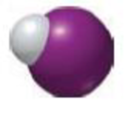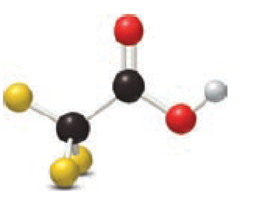
PRIN.OF GENERAL,ORGANIC+BIOLOG.CHEM.
2nd Edition
ISBN: 9781266811852
Author: SMITH
Publisher: MCG
expand_more
expand_more
format_list_bulleted
Concept explainers
Textbook Question
Chapter 8, Problem 8.32UKC
Draw the structure of the conjugate base of each acid.


Expert Solution & Answer
Want to see the full answer?
Check out a sample textbook solution
Students have asked these similar questions
how many moles of H2O2 are required to react with 11g of N2H4 according to the following reaction? (atomic weights: N=14.01, H=1.008, O= 16.00) 7H2O2 + N2H4 -> 2HNO3 + 8H20
calculate the number of moles of H2 produced from 0.78 moles of Ga and 1.92 moles HCL? 2Ga+6HCL->2GaCl3+3H2
an adult human breathes 0.50L of air at 1 atm with each breath. If a 50L air tank at 200 atm is available, how man y breaths will the tank provide
Chapter 8 Solutions
PRIN.OF GENERAL,ORGANIC+BIOLOG.CHEM.
Ch. 8.1 - Name each acid: (a) HF; (b) HNO3; (c) HCN.Ch. 8.1 - Prob. 8.2PCh. 8.1 - Which of the following species can be BrnstedLowry...Ch. 8.1 - Which of the following species can be BrnstedLowry...Ch. 8.1 - Classify each reactant as a BrnstedLowry acid or...Ch. 8.2 - Draw the conjugate acid of each species: (a) H2O;...Ch. 8.2 - Draw the conjugate base of each species: (a) H2S;...Ch. 8.2 - Draw the structure of the conjugate base of each...Ch. 8.2 - Label the acid and the base and the conjugate acid...Ch. 8.2 - Ammonia, NH3, is amphoteric. (a) Draw the...
Ch. 8.2 - When ascorbic acid (vitamin C, molecular formula...Ch. 8.3 - Prob. 8.12PCh. 8.3 - Prob. 8.13PCh. 8.3 - Prob. 8.14PCh. 8.3 - Prob. 8.15PCh. 8.4 - Calculate the value of [OH] from the given [H3O+]...Ch. 8.4 - Calculate the value of [H3O+] from the given [OH]...Ch. 8.4 - Calculate the value of [H3O+] and [OH] in each...Ch. 8.5 - Convert each H3O+ concentration to a pH value. a....Ch. 8.5 - What H3O+ concentration corresponds to each pH...Ch. 8.5 - Prob. 8.21PCh. 8.5 - Prob. 8.22PCh. 8.6 - Write a balanced equation for each acidbase...Ch. 8.6 - Prob. 8.24PCh. 8.6 - Prob. 8.25PCh. 8.6 - Write a balanced equation for the reaction of...Ch. 8.7 - Prob. 8.27PCh. 8.7 - Prob. 8.28PCh. 8.8 - Prob. 8.29PCh. 8.8 - Prob. 8.30PCh. 8 - Draw the structure of the conjugate base of each...Ch. 8 - Draw the structure of the conjugate base of each...Ch. 8 - (a) Which of the following represents a strong...Ch. 8 - Prob. 8.34UKCCh. 8 - Identify the acid, base, conjugate acid, and...Ch. 8 - Prob. 8.36UKCCh. 8 - Prob. 8.37UKCCh. 8 - Prob. 8.38UKCCh. 8 - Prob. 8.39UKCCh. 8 - Prob. 8.40UKCCh. 8 - If a urine sample has a pH of 5.90, calculate the...Ch. 8 - Prob. 8.42UKCCh. 8 - Prob. 8.43UKCCh. 8 - Prob. 8.44UKCCh. 8 - Consider a buffer prepared from the weak acid HNO2...Ch. 8 - Prob. 8.46UKCCh. 8 - Prob. 8.47APCh. 8 - Prob. 8.48APCh. 8 - Prob. 8.49APCh. 8 - Prob. 8.50APCh. 8 - Prob. 8.51APCh. 8 - Prob. 8.52APCh. 8 - Draw the conjugate base of each acid. a. HNO2 b....Ch. 8 - Draw the conjugate base of each acid. a. H3O+ b....Ch. 8 - Prob. 8.55APCh. 8 - Prob. 8.56APCh. 8 - Prob. 8.57APCh. 8 - Like H2O, H2PO4 is amphoteric. (a) Draw the...Ch. 8 - Prob. 8.59APCh. 8 - Prob. 8.60APCh. 8 - Prob. 8.61APCh. 8 - Prob. 8.62APCh. 8 - Prob. 8.63APCh. 8 - Prob. 8.64APCh. 8 - Prob. 8.65APCh. 8 - Prob. 8.66APCh. 8 - Prob. 8.67APCh. 8 - Prob. 8.68APCh. 8 - Calculate the value of [OH] from the given [H3O+]...Ch. 8 - Calculate the value of [OH] from the given [H3O+]...Ch. 8 - Calculate the value of [H3O+] from the given [OH]...Ch. 8 - Prob. 8.72APCh. 8 - Prob. 8.73APCh. 8 - Calculate the pH from each H3O+ concentration...Ch. 8 - Prob. 8.75APCh. 8 - Prob. 8.76APCh. 8 - What are the concentrations of H3O+ and OH in...Ch. 8 - Prob. 8.78APCh. 8 - Prob. 8.79APCh. 8 - Prob. 8.80APCh. 8 - Prob. 8.81APCh. 8 - Prob. 8.82APCh. 8 - Prob. 8.83APCh. 8 - Prob. 8.84APCh. 8 - Prob. 8.85APCh. 8 - Prob. 8.86APCh. 8 - Prob. 8.87APCh. 8 - Prob. 8.88APCh. 8 - Consider a weak acid H2A and its conjugate base...Ch. 8 - Consider a weak acid H2A and its conjugate base...Ch. 8 - Prob. 8.91APCh. 8 - Prob. 8.92APCh. 8 - Prob. 8.93APCh. 8 - Prob. 8.94APCh. 8 - The optimum pH of a swimming pool is 7.50....Ch. 8 - A sample of rainwater has a pH of 4.18. (a)...Ch. 8 - Prob. 8.97APCh. 8 - Prob. 8.98APCh. 8 - Prob. 8.99APCh. 8 - Explain why a lake on a bed of limestone is...Ch. 8 - Prob. 8.101CP
Knowledge Booster
Learn more about
Need a deep-dive on the concept behind this application? Look no further. Learn more about this topic, chemistry and related others by exploring similar questions and additional content below.Similar questions
- Using reaction free energy to predict equilibrium composition Consider the following equilibrium: 2NO2 (g) = N2O4(g) AGº = -5.4 kJ Now suppose a reaction vessel is filled with 4.53 atm of dinitrogen tetroxide (N2O4) at 279. °C. Answer the following questions about this system: Under these conditions, will the pressure of N2O4 tend to rise or fall? Is it possible to reverse this tendency by adding NO2? In other words, if you said the pressure of N2O4 will tend to rise, can that be changed to a tendency to fall by adding NO2? Similarly, if you said the pressure of N2O4 will tend to fall, can that be changed to a tendency to '2' rise by adding NO2? If you said the tendency can be reversed in the second question, calculate the minimum pressure of NO 2 needed to reverse it. Round your answer to 2 significant digits. 00 rise ☐ x10 fall yes no ☐ atm G Ar 1arrow_forwardWhy do we analyse salt?arrow_forwardCurved arrows are used to illustrate the flow of electrons. Using the provided starting and product structures, draw the curved electron-pushing arrows for the following reaction or mechanistic step(s). Be sure to account for all bond-breaking and bond-making steps. H H CH3OH, H+ H Select to Add Arrows H° 0:0 'H + Q HH ■ Select to Add Arrows CH3OH, H* H. H CH3OH, H+ HH ■ Select to Add Arrows i Please select a drawing or reagent from the question areaarrow_forward
- What are examples of analytical methods that can be used to analyse salt in tomato sauce?arrow_forwardA common alkene starting material is shown below. Predict the major product for each reaction. Use a dash or wedge bond to indicate the relative stereochemistry of substituents on asymmetric centers, where applicable. Ignore any inorganic byproducts H Šali OH H OH Select to Edit Select to Draw 1. BH3-THF 1. Hg(OAc)2, H2O =U= 2. H2O2, NaOH 2. NaBH4, NaOH + Please select a drawing or reagent from the question areaarrow_forwardWhat is the MOHR titration & AOAC method? What is it and how does it work? How can it be used to quantify salt in a sample?arrow_forward
- Predict the major products of this reaction. Cl₂ hv ? Draw only the major product or products in the drawing area below. If there's more than one major product, you can draw them in any arrangement you like. Be sure you use wedge and dash bonds if necessary, for example to distinguish between major products with different stereochemistry. If there will be no products because there will be no significant reaction, just check the box under the drawing area and leave it blank. Note for advanced students: you can ignore any products of repeated addition. Explanation Check Click and drag to start drawing a structure. 80 10 m 2025 McGraw Hill LLC. All Rights Reserved. Terms of Use | Privacy Center | Accessibility DII A F1 F2 F3 F4 F5 F6 F7 F8 EO F11arrow_forwardGiven a system with an anodic overpotential, the variation of η as a function of current density- at low fields is linear.- at higher fields, it follows Tafel's law.Calculate the range of current densities for which the overpotential has the same value when calculated for both cases (the maximum relative difference will be 5%, compared to the behavior for higher fields).arrow_forwardUsing reaction free energy to predict equilibrium composition Consider the following equilibrium: N2 (g) + 3H2 (g) = 2NH3 (g) AGº = -34. KJ Now suppose a reaction vessel is filled with 8.06 atm of nitrogen (N2) and 2.58 atm of ammonia (NH3) at 106. °C. Answer the following questions about this system: rise Under these conditions, will the pressure of N2 tend to rise or fall? ☐ x10 fall Is it possible to reverse this tendency by adding H₂? In other words, if you said the pressure of N2 will tend to rise, can that be changed to a tendency to fall by adding H2? Similarly, if you said the pressure of N will tend to fall, can that be changed to a tendency to rise by adding H₂? If you said the tendency can be reversed in the second question, calculate the minimum pressure of H₂ needed to reverse it. Round your answer to 2 significant digits. yes no ☐ atm Х ด ? olo 18 Ararrow_forward
arrow_back_ios
SEE MORE QUESTIONS
arrow_forward_ios
Recommended textbooks for you
- Chemistry: Matter and ChangeChemistryISBN:9780078746376Author:Dinah Zike, Laurel Dingrando, Nicholas Hainen, Cheryl WistromPublisher:Glencoe/McGraw-Hill School Pub Co
 Chemistry: The Molecular ScienceChemistryISBN:9781285199047Author:John W. Moore, Conrad L. StanitskiPublisher:Cengage Learning
Chemistry: The Molecular ScienceChemistryISBN:9781285199047Author:John W. Moore, Conrad L. StanitskiPublisher:Cengage Learning World of Chemistry, 3rd editionChemistryISBN:9781133109655Author:Steven S. Zumdahl, Susan L. Zumdahl, Donald J. DeCostePublisher:Brooks / Cole / Cengage Learning
World of Chemistry, 3rd editionChemistryISBN:9781133109655Author:Steven S. Zumdahl, Susan L. Zumdahl, Donald J. DeCostePublisher:Brooks / Cole / Cengage Learning  Organic Chemistry: A Guided InquiryChemistryISBN:9780618974122Author:Andrei StraumanisPublisher:Cengage Learning
Organic Chemistry: A Guided InquiryChemistryISBN:9780618974122Author:Andrei StraumanisPublisher:Cengage Learning Chemistry by OpenStax (2015-05-04)ChemistryISBN:9781938168390Author:Klaus Theopold, Richard H Langley, Paul Flowers, William R. Robinson, Mark BlaserPublisher:OpenStax
Chemistry by OpenStax (2015-05-04)ChemistryISBN:9781938168390Author:Klaus Theopold, Richard H Langley, Paul Flowers, William R. Robinson, Mark BlaserPublisher:OpenStax

Chemistry: Matter and Change
Chemistry
ISBN:9780078746376
Author:Dinah Zike, Laurel Dingrando, Nicholas Hainen, Cheryl Wistrom
Publisher:Glencoe/McGraw-Hill School Pub Co

Chemistry: The Molecular Science
Chemistry
ISBN:9781285199047
Author:John W. Moore, Conrad L. Stanitski
Publisher:Cengage Learning

World of Chemistry, 3rd edition
Chemistry
ISBN:9781133109655
Author:Steven S. Zumdahl, Susan L. Zumdahl, Donald J. DeCoste
Publisher:Brooks / Cole / Cengage Learning

Organic Chemistry: A Guided Inquiry
Chemistry
ISBN:9780618974122
Author:Andrei Straumanis
Publisher:Cengage Learning


Chemistry by OpenStax (2015-05-04)
Chemistry
ISBN:9781938168390
Author:Klaus Theopold, Richard H Langley, Paul Flowers, William R. Robinson, Mark Blaser
Publisher:OpenStax
General Chemistry | Acids & Bases; Author: Ninja Nerd;https://www.youtube.com/watch?v=AOr_5tbgfQ0;License: Standard YouTube License, CC-BY